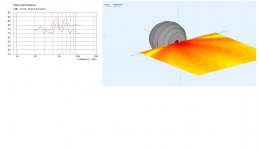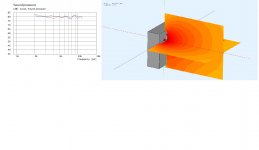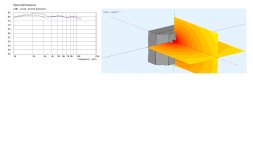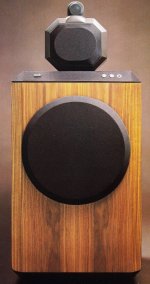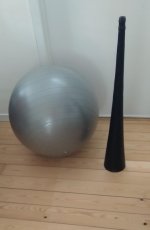I will have a look. Here in Europe some spheric speakers are made by hacking IKEA wood or metal salad bowl...A lot of shops are also solding thick soup bowl from asia for small loads (less than 1 liter. I used to try whyskey tube box of whiskey as well, not ideal shape though. but permitt on the lengthh to play with the mass-spring-mass law for attenuation.
Did you ever see the Focal "EGG"? That was REALLY cool!
Focal Egg Project | Parts Express Project Gallery
https://www.getthatprosound.com/wp-content/uploads/2017/11/extra-egg-150-inside-diagram.jpg
or this???
(I'm trying more but some images won't copy and paste)
I don't follow you exactly. My tweeter is the Fostex T90A designed for "top mount" My "mid" is the new MA P7PHD mounted in my "bread container". there are ZERO front baffle surfaces. If you looked at the front straight on; all you see are the drivers themselves. How can there be diffraction effects, etc. if there are NO edges other than those of the drivers themselves? I like the concept of a sphere (or rather a hemi-sphere) as a "baffle" and enclosure. I have limited space so minimizing front baffle area serves many goals; minimum diffraction effects plus a much less bulky space horizontally and vertically; the "space" involved and required is ALL behind the driver faces. Please elaborate; you have my attention here!
A drivers edge has no magic safeguard for diffraction.In your case it is the front of the baffle that diffracts. Any sharp bend diffract and the frequency where it starts is defined by the distance from the radiator. This is physics and cant be avoided. You freestanding tweeter diffract a lot, as seen by the post above with measurements. A tweeters baffle is small so diffraction starts quite high in frequency and might not be so audible, but it is there, believe me. The other problem with a small baffle is low acoustic impedance meaning you will lose level due to poor coupling to the air. This eventually means higher distorsion for the same level at listening position.
So, minimising front baffle is NOT minimising diffraction, you move it upwards in frequency yes. A big sphere (> 30-40 cm) is really good in this regard however.
//
A drivers edge has no magic safeguard for diffraction.In your case it is the front of the baffle that diffracts. Any sharp bend diffract and the frequency where it starts is defined by the distance from the radiator. This is physics and cant be avoided. You freestanding tweeter diffract a lot, as seen by the post above with measurements. A tweeters baffle is small so diffraction starts quite high in frequency and might not be so audible, but it is there, believe me. The other problem with a small baffle is low acoustic impedance meaning you will lose level due to poor coupling to the air. This eventually means higher distorsion for the same level at listening position.
So, minimising front baffle is NOT minimising diffraction, you move it upwards in frequency yes. A big sphere (> 30-40 cm) is really good in this regard however.
//
OK, makes sense. In my case; I don't notice any artifacts, major peaks or dips so I am happy with what I have. As I said, I don't have space in the room for large anything regardless of shape. Others have told me about REW which I loaded onto my PC. I hope to soon get a decent calibrated microphone so I can some actual measuring. I am retired so I do have plenty of time to play around with new or different ideas. I thought about open air for the mids but didn't like the sound. With what I have; the overall tonal balance is very good with minimal X/O work. I never get any distortion so my "bread container" is doing it's job. Even if I run the P7P full range; the cone motion never gets out of control; even if there is a lot of bass content. The only time things get out of hand is if I turn up the volume way past where I would normally ever listen I only did that as a test. So, for my room dimensions and listening habits; I'm perfectly happy with my results.
I guess if one were to build an enclosure with a large sphere or hemi-sphere surface; would you treat that with any sound absorbing materials on the external surfaces? What would be a good material to make such a thing out of? In the past; I have placed cork sheets and cork panels on the entire baffle board. Cork helps dampen, it helps seal and it acts a little like felt to "absorb" excess, unwanted sound energy off axis.
Cheers and thanks for the info!
Hi! I'm not sure that absorption on a sphere is wanted/necessary. There are no reflections or diffraction really from a sphere (thats the whole idea) hence, no need for absorption. Absorption is often frequency dependent so it would actually lead to less flat FR.
It's all a lovely multi dimensional chess game :-D
//
It's all a lovely multi dimensional chess game :-D
//
The thing with spheres is that the driver's frame usually is round. The transition from the driver's edge to the spherical enclosure is often too sharp-edged and since it is point symmetric the cumulative diffraction effects are nasty, especially on (and close off) axis. A highly regarded member of our Dutch community has performed BEM analysis on different shapes. I enclose his images, courtesy Tom Magchielse.
Conclusion is that the traditional box shape performs better. The funny thing is that Olson's discoveries also still hold their own, the box with (big) chamfering outperforms both other shapes. The enclosed images speak for themselves, red trace is on axis, black 30 degrees off.
Conclusion is that the traditional box shape performs better. The funny thing is that Olson's discoveries also still hold their own, the box with (big) chamfering outperforms both other shapes. The enclosed images speak for themselves, red trace is on axis, black 30 degrees off.
Attachments
OK, now we are raising my curiosity again! I just briefly looked at Dickason's LDC (edition 7). He has a chapter discussing shapes of enclosures and gives some of Olsen's original work here.
If you have this same edition as me; my enclosure would most likely resemble that of shape "J" in figures 5.1 A and B. It is certainly NOT shape C; a cylinder with the driver at the "end".
I have actually thought about adding modeling clay or plumber's putty or some other substance between the outer perimeter of the driver basket and the (barely exposed, fairly small) "corners" of my enclosure. No point in doing this though until I get a proper measuring set up because the effects are likely to be very small (I'm guessing).
I guess I will now read that entire chapter once again; it's been years so why not?
Severe weather in the the middle of the USA now not quite 4 AM central daylight time. Hope we don't get any more tornadoes! This is "tornado alley" and this time of the year; the atmosphere can get extremely unstable. HOPE I DON'T LOSE POWER! I live in a very old neighborhood with all overhead utilities so losing power is a common occurrence around here unfortunately!
If you have this same edition as me; my enclosure would most likely resemble that of shape "J" in figures 5.1 A and B. It is certainly NOT shape C; a cylinder with the driver at the "end".
I have actually thought about adding modeling clay or plumber's putty or some other substance between the outer perimeter of the driver basket and the (barely exposed, fairly small) "corners" of my enclosure. No point in doing this though until I get a proper measuring set up because the effects are likely to be very small (I'm guessing).
I guess I will now read that entire chapter once again; it's been years so why not?
Severe weather in the the middle of the USA now not quite 4 AM central daylight time. Hope we don't get any more tornadoes! This is "tornado alley" and this time of the year; the atmosphere can get extremely unstable. HOPE I DON'T LOSE POWER! I live in a very old neighborhood with all overhead utilities so losing power is a common occurrence around here unfortunately!
The configuration on the right can be seen in some studio monitors.
These are meant to be placed horizontal, so the recording engineer can better see the musicians in the recording room.
Iow in both cases the high and mid speakers must be vertical, because of the horizontal polar pattern.
The effect on polar pattern for the woofer is very small, because the distance between the acoustical centers in smaler than 1/4 the wavelength at the crossover point. This insures very limited lobing and thus a nice polar pattern.
Acoustic lobing - Wikipedia
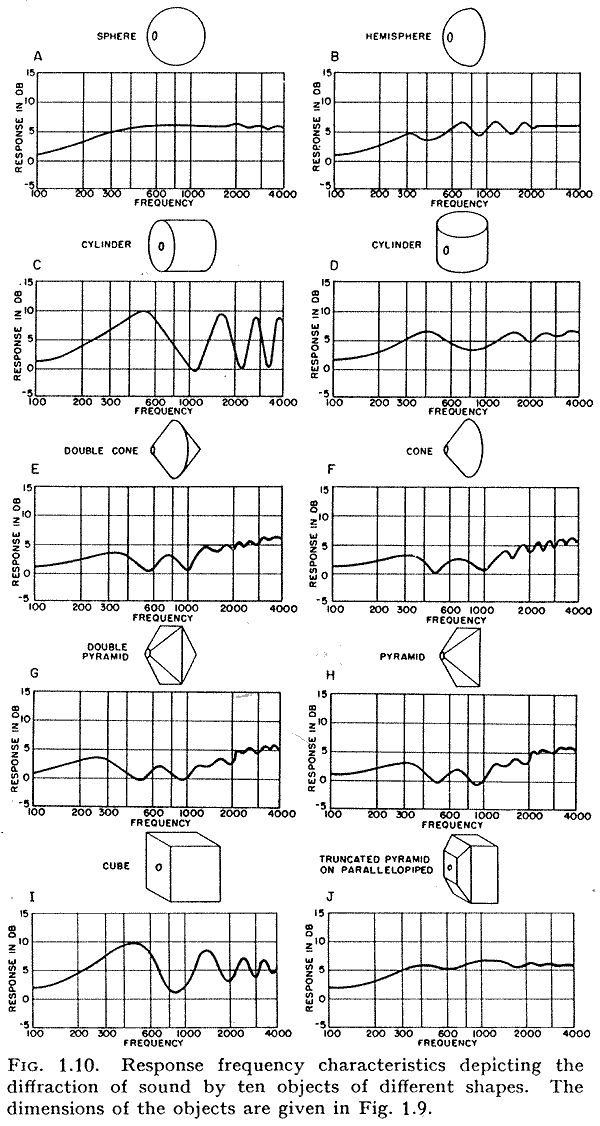
A is best, but unpractical.
J is second-best and a lot more practical.
Last edited:
OK, now we are raising my curiosity again! I just briefly looked at Dickason's LDC (edition 7). He has a chapter discussing shapes of enclosures and gives some of Olsen's original work here.
If you have this same edition as me; my enclosure would most likely resemble that of shape "J" in figures 5.1 A and B. It is certainly NOT shape C; a cylinder with the driver at the "end".
I have actually thought about adding modeling clay or plumber's putty or some other substance between the outer perimeter of the driver basket and the (barely exposed, fairly small) "corners" of my enclosure. No point in doing this though until I get a proper measuring set up because the effects are likely to be very small (I'm guessing).
I guess I will now read that entire chapter once again; it's been years so why not?
Severe weather in the the middle of the USA now not quite 4 AM central daylight time. Hope we don't get any more tornadoes! This is "tornado alley" and this time of the year; the atmosphere can get extremely unstable. HOPE I DON'T LOSE POWER! I live in a very old neighborhood with all overhead utilities so losing power is a common occurrence around here unfortunately!
Hang in there and prepare for going to the cellar if things get really bad!
I'm surprised of those simulations... I'm planning to build a 65cm dia sphere and put a 3" Faital full-range in it... there will be measurements... it will also be a while..
//
@TNT, you should drop the Faital for a nice Scan Speak 10F/8424G00 or the 10F/44... imho, you will make a lot of effort for your sphere for a driver that has anyway too much distorsion vs the ScanSpeak !
The tear drop shape behind the front half sphere will avoid you a unique resonant mode due to the internal 4Pi, not sure some brassing will help a lot here, but tear drop shape with progressive absorbption towards the back where the shape beam : yes ! Or maybe solid foam triangle Oldspkrguy showed elswhere in his construction thread, glued on the internal sphere... well perhaps... but you will recognise a unique internal strong mode is not what we want if that trade off can be avoided.
Two half wood or metal salad bowls from Ikea are easier though ! maybe the assembly between the two half sphere with a loosy material could also create a mix of sphere and cardioid behavior (and avoid also the uniq standalone internal mode of the sphere shape ????
@ old speaker guys : difraction is due to any stiff break up shape, so even a bullet tweeter has one at the outside of the barel, and if on a top of an enclosure (for time alignment purpose for instance), you will have also the difraction break up due to the mid enclosure where the tweeter stands. You certainly can this half tear drop behing the front half sphere by putting a rod at the center if the driver hole is not cuted already. Then with plastic bag, food thin film, etc, go from the top of the rod other side top till the half sphere and use plaster to mold or glass fiber. I have no manual skill (near zero) but if you have and/or facilities, worth to be tried ! Of course the internal volume has to be fulled to cope with the driver VAS but you know that. yu can also make that without wood rod : you "simply" put a loosy food film (for freezing purpose) behind the half sphere : at the center you put a double tape adhesive film tape with a piece of string you will pull then attach in order to use any plaster, glass fiber to shape around the film !
A nice easy way to deal with that though not as perfect than a half sphere is on a front bafle a square felt thick enough 1/2" for instance around the tweeter ut near the edge of the enclosure, at least on the two sides : it was patentented by Dunlavy that maked nice sounding speakers with perfect impulse response with his first order filter and simple enough enclosures (though time aligned by front panels recession).
The tear drop shape behind the front half sphere will avoid you a unique resonant mode due to the internal 4Pi, not sure some brassing will help a lot here, but tear drop shape with progressive absorbption towards the back where the shape beam : yes ! Or maybe solid foam triangle Oldspkrguy showed elswhere in his construction thread, glued on the internal sphere... well perhaps... but you will recognise a unique internal strong mode is not what we want if that trade off can be avoided.
Two half wood or metal salad bowls from Ikea are easier though ! maybe the assembly between the two half sphere with a loosy material could also create a mix of sphere and cardioid behavior (and avoid also the uniq standalone internal mode of the sphere shape ????
@ old speaker guys : difraction is due to any stiff break up shape, so even a bullet tweeter has one at the outside of the barel, and if on a top of an enclosure (for time alignment purpose for instance), you will have also the difraction break up due to the mid enclosure where the tweeter stands. You certainly can this half tear drop behing the front half sphere by putting a rod at the center if the driver hole is not cuted already. Then with plastic bag, food thin film, etc, go from the top of the rod other side top till the half sphere and use plaster to mold or glass fiber. I have no manual skill (near zero) but if you have and/or facilities, worth to be tried ! Of course the internal volume has to be fulled to cope with the driver VAS but you know that. yu can also make that without wood rod : you "simply" put a loosy food film (for freezing purpose) behind the half sphere : at the center you put a double tape adhesive film tape with a piece of string you will pull then attach in order to use any plaster, glass fiber to shape around the film !
A nice easy way to deal with that though not as perfect than a half sphere is on a front bafle a square felt thick enough 1/2" for instance around the tweeter ut near the edge of the enclosure, at least on the two sides : it was patentented by Dunlavy that maked nice sounding speakers with perfect impulse response with his first order filter and simple enough enclosures (though time aligned by front panels recession).
Last edited:
But imho all of this is showing the audio diyer illness : putting an average driver and invest in a complex enclosure is time lost imho. most important is as one knows the marriage in the XO area and time alignment and the reflexion of the tweeter in the room at listening position as the curve behavior off axis at the listening position : enclosure refinment are nice of course but cherry on the icing of the cake imho.
my two cents to focus your efforts & time
my two cents to focus your efforts & time
@TNT, you should drop the Faital for a nice Scan Speak 10F/8424G00 or the 10F/44... imho, you will make a lot of effort for your sphere for a driver that has anyway too much distorsion vs the ScanSpeak !
The tear drop shape behind the front half sphere will avoid you a unique resonant mode due to the internal 4Pi, not sure some brassing will help a lot here, but tear drop shape with progressive absorbption towards the back where the shape beam : yes ! Or maybe solid foam triangle Oldspkrguy showed elswhere in his construction thread, glued on the internal sphere... well perhaps... but you will recognise a unique internal strong mode is not what we want if that trade off can be avoided.
Two half wood or metal salad bowls from Ikea are easier though ! maybe the assembly between the two half sphere with a loosy material could also create a mix of sphere and cardioid behavior (and avoid also the uniq standalone internal mode of the sphere shape ????
@ old speaker guys : difraction is due to any stiff break up shape, so even a bullet tweeter has one at the outside of the barel, and if on a top of an enclosure (for time alignment purpose for instance), you will have also the difraction break up due to the mid enclosure where the tweeter stands. You certainly can this half tear drop behing the front half sphere by putting a rod at the center if the driver hole is not cuted already. Then with plastic bag, food thin film, etc, go from the top of the rod other side top till the half sphere and use plaster to mold or glass fiber. I have no manual skill (near zero) but if you have and/or facilities, worth to be tried ! Of course the internal volume has to be fulled to cope with the driver VAS but you know that. yu can also make that without wood rod : you "simply" put a loosy food film (for freezing purpose) behind the half sphere : at the center you put a double tape adhesive film tape with a piece of string you will pull then attach in order to use any plaster, glass fiber to shape around the film !
A nice easy way to deal with that though not as perfect than a half sphere is on a front bafle a square felt thick enough 1/2" for instance around the tweeter ut near the edge of the enclosure, at least on the two sides : it was patentented by Dunlavy that maked nice sounding speakers with perfect impulse response with his first order filter and simple enough enclosures (though time aligned by front panels recession).
I have the original stands for the Fostex T90A (bullet horn tweeter) but they raise the height from the "mid" I have several cork panels, 6 X 6 inches square, about 1/2 inch thick. I also have a lot of flat cork sheets. I also have 4 inch and 2 inch foam pyramids. I also have a lot of felt sheets. Based on this; would I be better off making a "J" shape truncated pyramid for the bullet tweeter also???
I suppose you guys are really getting my juices going here for a decent calibrated microphone. I must add again; I need boost starting around 8KHz, 8 to 10 dB at 10 KHz is about right for me up to about 15 KHz; above that; even 20 dB boost won't help. My Fostex has a custom 2nd order HP X/O about 16 KHz; the Q is about 0.85 to 0.87. This lies about half way between Butterworth and Chebyshev. Without any attenuation here; the higher Q roll-off blends in well with the Pluvia 7PHD at about the same point where it naturally starts it's roll-off (for MY hearing needs!!!). And; I do have separate amplifiers for the ST, mids, woofer, etc. all with individual gain controls.
Yesterday; I began playing with different X/O's for the P7PHD. Some of the best recordings do just fine with no X/O on the P7P but others sound just a little harsh in the highest overtones and harmonics of things like the violin highest notes, etc. There could be comb filtering or phasing effects going on here in this region between "mid" and ST...still fine tuning for best compromise and balance. In the past; I had a single inductor on the P7P but made it with a switch to by-pass...time for a measurement set up I guess. As a former musician though I am very good at normally sorting these things out on my own without any real measurements (test tones, sweeps, good recordings, etc.) and my own 2 trained ears...more later...thanks for all the good inputs!!!
I really dunno, so much factors, I'm lost myself ! In your case I will try first all the easiest solutions and judge with ears if good enough to live with :
Why not an horizontal square felt on the top of the cabinet aligned with the edge -so same size than the top but without felt in the middle, an empty square if you prefer : excuse my basic english- where the bullet tweeter stands ?
Beginns with a square à la Dunlavy, then a plain square, and adjust first the time alignement, then play with felt (the mixed ugly multicolor grey one under carpets than T gravsen uses or best the expensive white/beige wool ones that have nice looking and also can look good on a front panel ! You might also try the open cell foams : Yoga carpets : 10 usd at the sport shop : some are black, some are bi density with two colors !
Again Haberths speakers are squared cabinets and sound nice ... we 're talking icing on the cacke here imho (but hey I understand TNT : it's our hobby, isn'it ?)
... we 're talking icing on the cacke here imho (but hey I understand TNT : it's our hobby, isn'it ?)
Why not an horizontal square felt on the top of the cabinet aligned with the edge -so same size than the top but without felt in the middle, an empty square if you prefer : excuse my basic english- where the bullet tweeter stands ?
Beginns with a square à la Dunlavy, then a plain square, and adjust first the time alignement, then play with felt (the mixed ugly multicolor grey one under carpets than T gravsen uses or best the expensive white/beige wool ones that have nice looking and also can look good on a front panel ! You might also try the open cell foams : Yoga carpets : 10 usd at the sport shop : some are black, some are bi density with two colors !
Again Haberths speakers are squared cabinets and sound nice
@TNT, you should drop the Faital for a nice Scan Speak 10F/8424G00 or the 10F/44... imho, you will make a lot of effort for your sphere for a driver that has anyway too much distorsion vs the ScanSpeak !
The tear drop shape behind the front half sphere will avoid you a unique resonant mode due to the internal 4Pi, not sure some brassing will help a lot here, but tear drop shape with progressive absorbption towards the back where the shape beam
I do own a pair of 10f/ so I might try them also. The sphere is just a baffle. The driver will play into a reversed exponential horn i.e. a completely different cavity than the sphere. The driver and the sphere will not have physical contact.
Some of the tings to help the implementation
//
Attachments
I really dunno, so much factors, I'm lost myself ! In your case I will try first all the easiest solutions and judge with ears if good enough to live with :
Why not an horizontal square felt on the top of the cabinet aligned with the edge -so same size than the top but without felt in the middle, an empty square if you prefer : excuse my basic english- where the bullet tweeter stands ?
Beginns with a square à la Dunlavy, then a plain square, and adjust first the time alignement, then play with felt (the mixed ugly multicolor grey one under carpets than T gravsen uses or best the expensive white/beige wool ones that have nice looking and also can look good on a front panel ! You might also try the open cell foams : Yoga carpets : 10 usd at the sport shop : some are black, some are bi density with two colors !
Again Haberths speakers are squared cabinets and sound nice... we 're talking icing on the cacke here imho (but hey I understand TNT : it's our hobby, isn'it ?)
My "felt" is a synthetic poly'/wool blend. It is for a pad underneath of an area rug; it does a very good job even though it is not 100% lamb's wool felt. What you said above; I have already done with my cork panels. Maybe I can do cork panels with felt on top? I can always use the foam pyramids further out. I guess next pay day I'll be getting a microphone set up to match with the free REW software I just recently installed. Any microphone suggestions??? I have had some people already tell me about a few choices; I would to keep the price in the $100 US or under range UNLESS, there is a far more accurate set for say $150 US + ???
TNT,
You know what ? It's modern art : would stay like that and just paint the ball with another color : Mars red... quite serious here and my taste are going more towards classic art, but hey it's looks good here !
Well quite interrested by your project, I had help from Joseph Crowe to draw a horn to load the scan speak till 800 hz where I plana Xover with a PA 15" -the famous Faital 15PR400 which stays nice for my low budget wallet- : then I saw 3d printed matricesas mold possibility at diyaudio to use plaster or any composit. CNC is expensive !
So subscribed if you plan a thread ... you have much more knowledge than I have, I have zero technical background, just a music lover here with poor manua skill (and english skill) but a HiFi passion of course - btw we all disearve medecine invent a therapy class for all of us, uh
... you have much more knowledge than I have, I have zero technical background, just a music lover here with poor manua skill (and english skill) but a HiFi passion of course - btw we all disearve medecine invent a therapy class for all of us, uh
You know what ? It's modern art : would stay like that and just paint the ball with another color : Mars red... quite serious here and my taste are going more towards classic art, but hey it's looks good here !
Well quite interrested by your project, I had help from Joseph Crowe to draw a horn to load the scan speak till 800 hz where I plana Xover with a PA 15" -the famous Faital 15PR400 which stays nice for my low budget wallet- : then I saw 3d printed matricesas mold possibility at diyaudio to use plaster or any composit. CNC is expensive !
So subscribed if you plan a thread
Last edited:
No idea on the mic : don't know what soundcard you have, if it as 48v phantom powersupply, etc ! Plenty of choise, for instance the last Dayton that can be used as head mimic at sweet spot position as well !
Some say the ECM8000 is good enough despite not calibrated (at least there is a calibrated file but it's generic and there is inconsitency in the mic production, so it's throwing dices) . Dayton is a clone with same philosophy for calibration (not individualy made at this price... but that is matter that much in our cases for few diy projects ?! Up to you to move the usd cursor
Dickason was using a cheap pacific palissad shop mic ????
Sorry : Edit, I mde a mistake : the head mimic mic is a minidsp : MINIDSP AMBIMIK-1 Ambisonic USB Microphone 32bit 192kHz ASIO Dirac - Audiophonics
too much epensive for what it is in front of serious specialised company that calibrate mics on demand (or sold theirs). The Ecm8000 clones are chinese certainly from the same company and factory : looks all the same measurement microphone - Audiophonics ; Measurement Microphones – Thomann UK
Some say the ECM8000 is good enough despite not calibrated (at least there is a calibrated file but it's generic and there is inconsitency in the mic production, so it's throwing dices) . Dayton is a clone with same philosophy for calibration (not individualy made at this price... but that is matter that much in our cases for few diy projects ?! Up to you to move the usd cursor
Dickason was using a cheap pacific palissad shop mic ????
Sorry : Edit, I mde a mistake : the head mimic mic is a minidsp : MINIDSP AMBIMIK-1 Ambisonic USB Microphone 32bit 192kHz ASIO Dirac - Audiophonics
too much epensive for what it is in front of serious specialised company that calibrate mics on demand (or sold theirs). The Ecm8000 clones are chinese certainly from the same company and factory : looks all the same measurement microphone - Audiophonics ; Measurement Microphones – Thomann UK
Last edited:
- Home
- Loudspeakers
- Multi-Way
- Effects of mid/tweeter different layout
